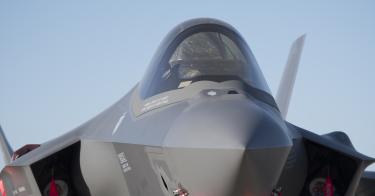A key component in the F-35 fighter jet is made in China. And the Defense Department just found out about it. It’s illustrative of a much bigger problem with defense supply chains—one that policymakers have a responsibility to solve.
On Sept. 7, multiple outlets reported that the Pentagon halted deliveries of Lockheed Martin’s F-35 after finding that a cobalt and samarium alloy used in magnets for the plane’s pumps was made in China. Federal regulations ban the use of certain specialty metals and alloys produced in China, Iran, North Korea and Russia in defense equipment.
Chinese components in the F-35 are problematic. China is the U.S.’s chief competitor and allowing our military programs to be dependent on Chinese companies or resources makes those programs vulnerable.
Lockheed Martin says that the particular alloy that triggered the Pentagon’s hold on F-35 deliveries can be acquired from a U.S. producer. If so, then what’s the big deal? Why does this incident matter?
>>> Do More To Prevent Chinese Espionage
For starters, it matters because it delays delivery of F-35s. While a U.S. producer has been identified, the company will need to prove its material meets the military’s specifications. In the meantime: the impacted magnet supplier must stop work on that particular magnet; the lube pump supplier has to stop work while waiting for the magnets; Honeywell has to stop work on the turbomachine while waiting for the lube pumps, and Lockheed Martin can’t assemble F-35s while it waits for the turbomachines. This domino effect means that, even if the noncompliant alloy issue is resolved quickly, the delay may last longer.
More troubling, this incident demonstrates that the Defense Department has little direct knowledge of what goes into the planes, ships, tanks, and other weapons it buys. And that’s a big problem.
To take this discussion to “first principles,” the United States needs a strong national defense to protect itself and its interests from foreign threats. This requires a strong military, with all the necessary equipment and weapons. Military equipment and supplies contain millions of components made by hundreds of thousands of suppliers. So, in order to have a strong national defense, the U.S. needs secure access to weapons production, which means secure supply chains for those weapons.
The trouble is, the Department of Defense has a very limited idea whether the supply chains for key defense items are indeed secure. The Pentagon does not keep track of who produces the many components in its weapons systems. Instead, prime contractors (in this case, Lockheed Martin) are made responsible for ensuring the resilience and knowledge of the supply chain of their end product. But “primes” in turn require their subcontractors to be responsible for their supply chains, and the subcontractors do the same for their subcontractors, and so on down the chain.
The end result is that prime contractors usually only fully know and understand their supply chains down through the first few tiers. No one actor holds all the supply chain information for, say, the F-35 or the Virginia-class submarine. The Defense Department only learns about supply chain vulnerabilities when word trickles up from below, as in the case of the Chinese magnets.
Here’s how the Pentagon found out about this violation: they heard from Lockheed Martin, who heard from Honeywell (the maker of the F-35 turbomachine), who heard from its lube pump supplier, who heard from its magnet supplier that they had used an alloy manufactured in China.
This unreliable game of telephone has, in this case, very real costs. The Air Force already had a capacity problem, and now F-35 deliveries are halted indefinitely.
>>> China’s Nuclear Expansion and its Implications for U.S. Strategy and Security
This imperfect knowledge of who makes what, where, extends across all defense supply chains. And it carries huge risks. If the U.S. went to war with China, economic ties between the countries would be completely severed. The Pentagon would quickly learn which defense components were made in China—because contractors suddenly wouldn’t have access to them. Production of key weapons could grind to a halt at a time when those weapons would be desperately needed.
The first step to mitigate these risks is to greatly increase the Pentagon’s vision into defense supply chains.
Increasing supply chain visibility is no small challenge. Private companies are often unwilling to share their proprietary business data with the government, and supplier relationships are constantly changing anyway, making it hard to capture a complete supply chain picture.
However, advances in technologies like blockchain and artificial intelligence make gathering, updating, and monitoring supply chain information on this scale more feasible than it was even a few years ago. The Defense Department has a responsibility to explore how these technologies could fix its supply chain blind spots, and Congress should use its powers to make sure this happens.
Defense supply chain visibility will be challenging, but it is now possible. Given our high-stakes strategic competition with China, pursuing it is more important than ever.
This piece originally appeared in RealClear Defense




